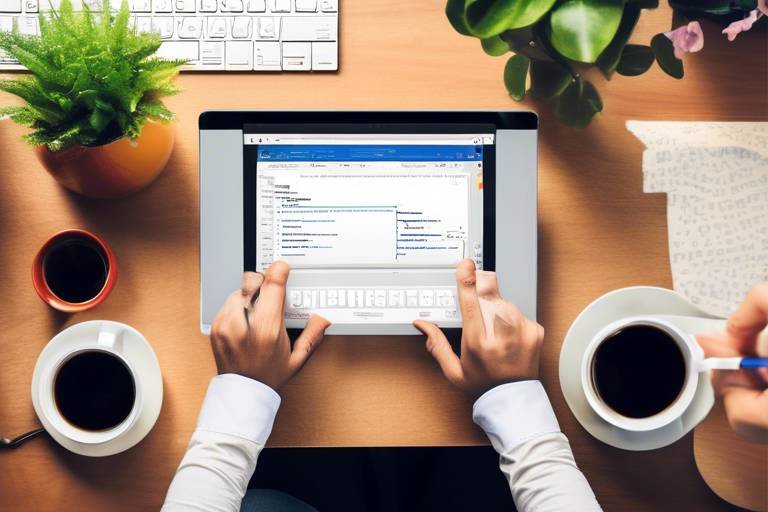How to Use Gamification to Enhance Task Completion
Gamification is a powerful technique that can significantly boost engagement and motivation levels when implemented correctly. By integrating game elements into tasks, individuals are not only more likely to complete them successfully but also enjoy the process. Let's delve into the world of gamification and explore how it can be effectively utilized to enhance task completion.

Understanding Gamification
Gamification is a powerful tool that can increase engagement and motivation. By incorporating game elements into tasks, individuals are more likely to complete them successfully and enjoy the process. Discover how to effectively implement gamification strategies for improved task completion.
Gamification involves applying game design elements in non-game contexts to motivate and engage users. By leveraging elements like points, badges, leaderboards, and challenges, organizations can enhance user participation and task completion rates.
Gamification can lead to increased productivity, improved learning outcomes, and enhanced user satisfaction. When tasks are gamified, individuals are more likely to stay motivated, focused, and committed to completing them in a timely manner.
Gamification captures users' attention and encourages active participation in tasks. By introducing elements of competition, collaboration, and reward systems, individuals feel more engaged and enthusiastic about completing their objectives.
Gamification taps into individuals' intrinsic motivators, such as achievement, recognition, and progress. By providing clear goals, instant feedback, and tangible rewards, gamified tasks can boost motivation levels and drive performance.
Gamification promotes experiential learning by allowing users to practice skills in a safe and interactive environment. Through challenges, simulations, and feedback mechanisms, individuals can enhance their knowledge and abilities while completing tasks.
Successful gamification requires careful planning, clear objectives, and effective design. By understanding the target audience, setting meaningful goals, and selecting appropriate game mechanics, organizations can create engaging gamified experiences for task completion.
Define specific, achievable goals that align with the overall task objectives. By setting clear expectations and milestones, individuals have a clear roadmap to follow, increasing their focus and commitment to task completion.
Offer immediate feedback on users' progress and performance to keep them informed and motivated. By providing feedback on their actions and achievements, individuals can track their progress and make necessary adjustments to improve their performance.

Benefits of Gamification in Task Completion
Gamification is a powerful tool that can increase engagement and motivation. By incorporating game elements into tasks, individuals are more likely to complete them successfully and enjoy the process. Discover how to effectively implement gamification strategies for improved task completion.
Gamification involves applying game design elements in non-game contexts to motivate and engage users. By leveraging elements like points, badges, leaderboards, and challenges, organizations can enhance user participation and task completion rates.
Gamification can lead to increased productivity, improved learning outcomes, and enhanced user satisfaction. When tasks are gamified, individuals are more likely to stay motivated, focused, and committed to completing them in a timely manner.
Gamification captures users' attention and encourages active participation in tasks. By introducing elements of competition, collaboration, and reward systems, individuals feel more engaged and enthusiastic about completing their objectives.
Gamification taps into individuals' intrinsic motivators, such as achievement, recognition, and progress. By providing clear goals, instant feedback, and tangible rewards, gamified tasks can boost motivation levels and drive performance.
Gamification promotes experiential learning by allowing users to practice skills in a safe and interactive environment. Through challenges, simulations, and feedback mechanisms, individuals can enhance their knowledge and abilities while completing tasks.
Successful gamification requires careful planning, clear objectives, and effective design. By understanding the target audience, setting meaningful goals, and selecting appropriate game mechanics, organizations can create engaging gamified experiences for task completion.
Define specific, achievable goals that align with the overall task objectives. By setting clear expectations and milestones, individuals have a clear roadmap to follow, increasing their focus and commitment to task completion.
Offer immediate feedback on users' progress and performance to keep them informed and motivated. By providing feedback on their actions and achievements, individuals can track their progress and make necessary adjustments to improve their performance.

Increased Engagement
When it comes to task completion, plays a crucial role in driving individuals towards successfully finishing their objectives. Gamification excels in capturing users' attention and fostering active participation through various means. By incorporating elements of competition, collaboration, and reward systems, gamification creates an environment where individuals feel not only motivated but also enthusiastic about completing their tasks.
Imagine a scenario where completing a task feels like embarking on an exciting quest, with challenges to overcome and rewards to earn along the way. This sense of adventure and accomplishment keeps users hooked and eager to progress further. With gamification, tasks become more than just mundane to-dos; they transform into engaging experiences that users actively want to participate in.
Moreover, increased engagement leads to a sense of community and connection among users. Through shared experiences, challenges, and achievements, individuals can form bonds and support each other in their task completion journey. This sense of belonging further enhances engagement levels and encourages users to stay committed until the task is successfully completed.

Boosted Motivation
Boosted Motivation involves tapping into individuals' intrinsic motivators, such as achievement, recognition, and progress. When tasks are gamified, clear goals are provided to give a sense of accomplishment. Imagine it like leveling up in a video game – each completed task is like gaining experience points that bring you closer to the next level. This sense of progress can significantly boost motivation levels, keeping individuals engaged and driven to perform better.

Enhanced Learning and Skill Development
Gamification is not just about completing tasks; it's also a powerful tool for enhancing learning and skill development. Imagine a scenario where learning a new skill feels like playing a challenging game. With gamification, users can engage in interactive experiences that promote experiential learning and skill enhancement.
Through gamified tasks, individuals can practice and apply new skills in a safe and controlled environment. Think of it as a virtual training ground where users can make mistakes, learn from them, and improve without real-world consequences. This hands-on approach to learning fosters a deeper understanding of concepts and boosts skill proficiency.
Moreover, gamification encourages continuous skill development through challenges and feedback mechanisms. Users receive instant feedback on their actions, allowing them to identify areas for improvement and refine their techniques. By iteratively engaging with gamified tasks, individuals can master new skills and knowledge more effectively than traditional learning methods.
Furthermore, gamification promotes active participation and engagement in the learning process. By integrating elements like quizzes, simulations, and interactive content, users are motivated to explore, experiment, and discover new information. This dynamic learning environment not only enhances retention but also cultivates a sense of achievement and progress.
Overall, gamification offers a holistic approach to learning and skill development by combining engagement, interactivity, and feedback. By transforming educational content into immersive experiences, gamification revolutionizes the way individuals acquire knowledge and hone their skills.

Implementing Gamification Strategies
Gamification is a powerful tool that can increase engagement and motivation. By incorporating game elements into tasks, individuals are more likely to complete them successfully and enjoy the process. Discover how to effectively implement gamification strategies for improved task completion.
Gamification involves applying game design elements in non-game contexts to motivate and engage users. By leveraging elements like points, badges, leaderboards, and challenges, organizations can enhance user participation and task completion rates.
Gamification can lead to increased productivity, improved learning outcomes, and enhanced user satisfaction. When tasks are gamified, individuals are more likely to stay motivated, focused, and committed to completing them in a timely manner.
Gamification captures users' attention and encourages active participation in tasks. By introducing elements of competition, collaboration, and reward systems, individuals feel more engaged and enthusiastic about completing their objectives.
Gamification taps into individuals' intrinsic motivators, such as achievement, recognition, and progress. By providing clear goals, instant feedback, and tangible rewards, gamified tasks can boost motivation levels and drive performance.
Gamification promotes experiential learning by allowing users to practice skills in a safe and interactive environment. Through challenges, simulations, and feedback mechanisms, individuals can enhance their knowledge and abilities while completing tasks.
Successful gamification requires careful planning, clear objectives, and effective design. By understanding the target audience, setting meaningful goals, and selecting appropriate game mechanics, organizations can create engaging gamified experiences for task completion.
Define specific, achievable goals that align with the overall task objectives. By setting clear expectations and milestones, individuals have a clear roadmap to follow, increasing their focus and commitment to task completion.
Offer immediate feedback on users' progress and performance to keep them informed and motivated. By providing feedback on their actions and achievements, individuals can track their progress and make necessary adjustments to improve their performance.

Setting Clear Goals and Objectives
When it comes to implementing gamification strategies for task completion, setting clear goals and objectives is paramount. These goals act as guiding stars, leading individuals towards successful task completion. By defining specific, achievable objectives that align with the overall task requirements, organizations can effectively harness the power of gamification to drive engagement and motivation.
Imagine setting sail on a ship without a destination in mind. Without clear goals, individuals may feel lost, unsure of where to focus their efforts. Similarly, in the realm of task completion, clear objectives provide a sense of direction, outlining the path that needs to be traversed. When users have a clear understanding of what they need to achieve, they are more likely to stay on track and motivated throughout the journey.
Moreover, setting clear goals and objectives creates a sense of purpose and meaning behind the tasks at hand. It transforms mundane activities into meaningful challenges, sparking individuals' intrinsic motivation to excel and succeed. By breaking down larger tasks into smaller, manageable goals, organizations can instill a sense of accomplishment with each milestone achieved, fueling users' drive to progress further.
Furthermore, clear goals and objectives serve as beacons of progress, allowing individuals to track their advancement and measure their success. Just as signposts mark the path in a dense forest, defined goals provide users with checkpoints to gauge their performance and adjust their strategies accordingly. This real-time feedback loop not only enhances user awareness but also empowers them to make informed decisions to improve their task completion efficiency.

Providing Real-Time Feedback
Providing real-time feedback is a crucial aspect of successful gamification strategies. By offering immediate feedback on users' progress and performance, organizations can keep individuals informed and motivated throughout the task completion process. Real-time feedback allows users to track their actions and achievements, enabling them to make necessary adjustments to improve their performance.
Frequently Asked Questions
- What is gamification and how does it enhance task completion?
Gamification is the practice of incorporating game elements, such as points, badges, and challenges, into non-game contexts to motivate and engage users. By making tasks more interactive and rewarding, gamification increases user engagement, motivation, and ultimately improves task completion rates.
- What are the benefits of using gamification in task completion?
Gamification offers several benefits, including increased productivity, improved learning outcomes, and enhanced user satisfaction. When tasks are gamified, individuals are more likely to stay motivated, focused, and committed to completing them in a timely manner, leading to better overall results.
- How does gamification boost motivation and learning?
Gamification taps into individuals' intrinsic motivators, such as achievement, recognition, and progress. By providing clear goals, instant feedback, and tangible rewards, gamified tasks can boost motivation levels and drive performance. Additionally, gamification promotes experiential learning by allowing users to practice skills in a safe and interactive environment, leading to enhanced learning and skill development.



















